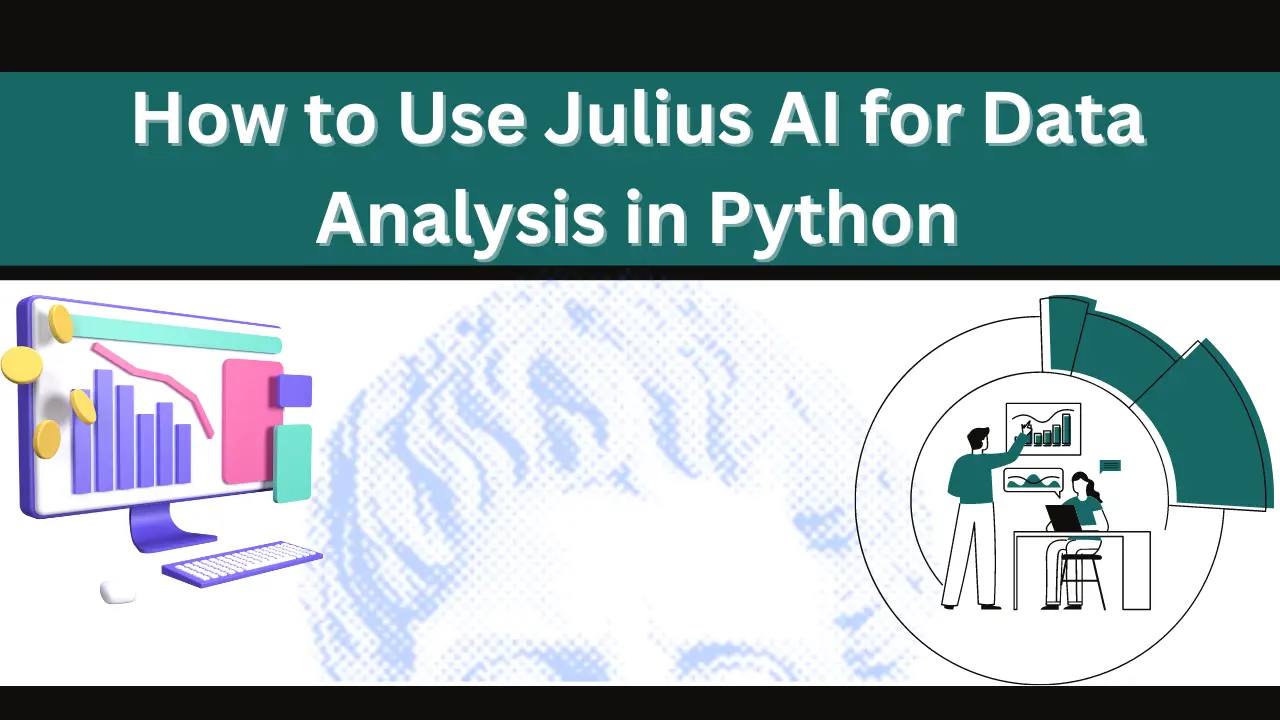Data analysis is a crucial part of many fields, from business to science. It helps to make sense of large amounts of data, finding patterns and insights. Python is a popular programming language for data analysis. It is easy to learn and has many powerful libraries. One of the new tools for data analysis in Python is Julius AI. This article will guide you on how to use Julius AI for data analysis in Python.
What is Julius AI?
Julius AI is an artificial intelligence platform. It provides various tools for data analysis, including machine learning, data visualization, and data management. Julius AI aims to simplify the process of analyzing data by offering an intuitive interface and powerful features.

Setting Up Julius AI in Python
Installing Julius AI
To use Julius AI in Python, you first need to install it. You can install Julius AI using pip, which is Python’s package installer. Open your terminal or command prompt and type:
pip install julius-ai
This command will download and install Julius AI and its dependencies.
Importing Julius AI
After installing Julius AI, you need to import it into your Python script. You can do this by adding the following line at the beginning of your script:
import julius_ai as ja
This line imports Julius AI and gives it the alias ja to make it easier to use.
Loading Data
Before you can analyze data, you need to load it into your Python script. Julius AI supports various data formats, including CSV, Excel, and JSON. Here is an example of how to load a CSV file:
data = ja.load_csv('data.csv')
This line loads the data from a CSV file named data.csv into a variable called data.
Exploring the Data
Viewing the Data
Once the data is loaded, you can view the first few rows to get an idea of what it looks like. You can do this using the head method:
print(data.head())
This command prints the first five rows of the data. You can also specify the number of rows to display by passing a number to the head method:
print(data.head(10))
Summary Statistics
You can also get summary statistics of the data using the describe method:
print(data.describe())
This command prints various summary statistics, including the mean, standard deviation, minimum, and maximum values for each column.
Cleaning the Data
Data often needs to be cleaned before analysis. This can include handling missing values, removing duplicates, and correcting errors.
Handling Missing Values
To check for missing values, you can use the isnull and sum methods:
print(data.isnull().sum())
This command prints the number of missing values in each column. To handle missing values, you can use the fillna method to fill them with a specific value, or the dropna method to remove rows with missing values:
data = data.fillna(0)
# or
data = data.dropna()
Removing Duplicates
To remove duplicate rows, you can use the drop_duplicates method:
data = data.drop_duplicates()
This command removes any duplicate rows from the data.
Analyzing the Data
Data Visualization
Data visualization is a key part of data analysis. It helps to understand the data and find patterns. Julius AI integrates with popular visualization libraries like Matplotlib and Seaborn.
Plotting with Matplotlib
Here is an example of how to create a simple line plot using Matplotlib:
import matplotlib.pyplot as plt
plt.plot(data['column1'], data['column2'])
plt.xlabel('Column 1')
plt.ylabel('Column 2')
plt.title('Line Plot')
plt.show()
This code creates a line plot of column1 against column2.
Plotting with Seaborn
Seaborn is another powerful visualization library. Here is an example of how to create a scatter plot using Seaborn:
import seaborn as sns
sns.scatterplot(x='column1', y='column2', data=data)
plt.xlabel('Column 1')
plt.ylabel('Column 2')
plt.title('Scatter Plot')
plt.show()
This code creates a scatter plot of column1 against column2.
Machine Learning
Julius AI also supports machine learning. You can use it to build and train models, and make predictions.
Splitting the Data
Before building a model, you need to split the data into training and testing sets. This can be done using the train_test_split function from the sklearn.model_selection module:
from sklearn.model_selection import train_test_split
X = data[['column1', 'column2']]
y = data['target']
X_train, X_test, y_train, y_test = train_test_split(X, y, test_size=0.2, random_state=42)
This code splits the data into training and testing sets, with 80% of the data used for training and 20% for testing.
Building a Model
Julius AI supports various machine learning algorithms, including linear regression, decision trees, and neural networks. Here is an example of how to build a linear regression model:
from sklearn.linear_model import LinearRegression
model = LinearRegression()
model.fit(X_train, y_train)
This code creates a linear regression model and trains it on the training data.
Making Predictions
Once the model is trained, you can use it to make predictions on the testing data:
predictions = model.predict(X_test)
print(predictions)
This code makes predictions on the testing data and prints them.
Evaluating the Model
To evaluate the model, you can use various metrics, such as mean squared error (MSE) and R-squared. Here is an example of how to calculate MSE:
from sklearn.metrics import mean_squared_error
mse = mean_squared_error(y_test, predictions)
print('Mean Squared Error:', mse)
This code calculates and prints the mean squared error of the model.
Advanced Data Analysis with Julius AI
Clustering
Clustering is a technique used to group similar data points together. Julius AI supports various clustering algorithms, including K-means.
Here is an example of how to perform K-means clustering:
from sklearn.cluster import KMeans
kmeans = KMeans(n_clusters=3)
kmeans.fit(data[['column1', 'column2']])
data['cluster'] = kmeans.labels_
print(data)
This code performs K-means clustering with three clusters and adds the cluster labels to the data.
Dimensionality Reduction
Dimensionality reduction is a technique used to reduce the number of features in the data. Julius AI supports various dimensionality reduction algorithms, including Principal Component Analysis (PCA).
Here is an example of how to perform PCA:
from sklearn.decomposition import PCA
pca = PCA(n_components=2)
pca_result = pca.fit_transform(data[['column1', 'column2', 'column3']])
data['pca1'] = pca_result[:, 0]
data['pca2'] = pca_result[:, 1]
print(data)
This code performs PCA and adds the principal components to the data.
Conclusion
Julius AI is a powerful tool for data analysis in Python. It provides various features, including data loading, cleaning, visualization, and machine learning. By following this guide, you can start using Julius AI for your data analysis tasks. Remember to always explore and clean your data before analysis, and choose the right tools and techniques for your specific needs. Happy analyzing!
This article has provided a comprehensive introduction to using Julius AI for data analysis in Python. By following the steps outlined, you can leverage the powerful features of Julius AI to gain insights from your data. Whether you are a beginner or an experienced data analyst, Julius AI can help you streamline your workflow and achieve better results.
FAQs: Use Julius AI for data analysis in python
Is Julius AI suitable for beginners in data analysis?
Yes, Julius AI is suitable for beginners. It provides an intuitive interface and powerful features that simplify the data analysis process. With basic knowledge of Python, you can start using Julius AI for your data analysis tasks.
Where can I find more resources to learn Julius AI?
You can find more resources, tutorials, and documentation on the Julius AI official website and various online learning platforms that offer courses on data analysis and machine learning in Python. Additionally, community forums and GitHub repositories can be helpful for practical examples and code snippets.
What is Julius AI used for?
Julius AI is a platform designed for data analysis, machine learning, and data visualization. It helps users analyze large datasets, build predictive models, and visualize data insights easily.
How do I install Julius AI in Python?
You can install Julius AI using pip, Python’s package installer. Open your terminal or command prompt and type below code:pip install julius-ai
This command will download and install Julius AI and its dependencies.
How do I load data into Julius AI?
You can load data into Julius AI using various methods, depending on the data format. For example, to load a CSV file, you can use: import julius_ai as ja data = ja.load_csv('data.csv')
This loads the data from the specified CSV file into a variable called data.




